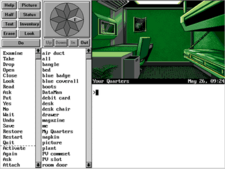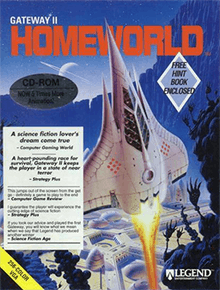Gateway (video game)
Gateway is a duology of interactive fiction video games released by Legend Entertainment, and written by Glen Dahlgren and Mike Verdu. It is based on Frederik Pohl's Heechee universe. The first game, Frederik Pohl's Gateway, was released in 1992 for DOS and re-released for Windows in 1995. Its direct sequel, Gateway II: Homeworld, was released in 1993. Βoth games have virtually identical interfaces that hybridize traditional parsers with illustration and mouse-based aids. The games (especially the second) have a number of timed events, but the possibility of player death outside them is quite rare. Unwinnable states are possible, but difficult to achieve.
| Gateway | |
|---|---|
 DOS cover art of the first game | |
| Developer(s) | Legend Entertainment |
| Publisher(s) | Legend Entertainment |
| Designer(s) | Glen Dahlgren Mike Verdu |
| Series | Heechee |
| Platform(s) | DOS, Windows |
| Release | June 1992 (I)[1] December, 1993 (II) |
| Genre(s) | Interactive fiction, Adventure |
| Mode(s) | Single-player |
In 1996 Legend Entertainment made the entire first game available for free download from its website.[2]
Synopsis
Setting
A century in the future, humans land on Venus and colonize it. Below the surface, thousands of miles of artificial tunnels are discovered. They are believed to have been built thousands of years ago by an alien species known as the Heechee, but little else is known about them until an explorer discovers a Heechee ship, intact and operational, in one of the tunnels.
Rather than report his findings, he climbs in and activate it. The ship launches and goes into "TAU Space," a faster-than-light travel method. It arrives at a huge space station carved out of an asteroid floating halfway between Venus and Mercury, which is full of thousands of similar ships, but otherwise empty. However, the explorer is unable to figure out how to return to Venus, and faced with a lack of supplies, figures out how to detonate the fuel cell of the ship he came in. The detonation kills him, but also attracts the attention of a NASA tracking station, who send an expedition to investigate.
The discovery of the station and its ships allow humanity to travel into deep space. Although they were unable to reverse engineer the Heechee technology, they can use the ships' stored destinations and the station becomes humanity's "Gateway" to outer space, hence the name. This almost leads to war among the superpowers of Earth over ownership, until a compromise is finally worked out. A co-operative called the Gateway Corporation is formed, with the superpowers each holding one quarter of company stock.
The alien ships that are found still function, but their built-in destinations are a mystery. Navigation is accomplished by using 5 digit codes with the ships' computers, but there is no way to tell what codes go where. Volunteers called prospectors come to Gateway to test the codes and pilot the ships to their destination, explore and report back what they find (as well as bring anything interesting back). A large majority of the prospectors return with little or nothing, a tenth never return, but the remaining 1.5% return with artifacts or knowledge that make them incredibly rich.
Plot
Gateway

The player character has won a one-way ticket to Gateway, membership as a prospector in the Gateway Corporation and 10 days of provided life support along with a small amount of money. The player begins as a Prospector and follows procedures in order to know Gateway better and afterwards begin exploring Heechee coordinates. The findings are important enough to get him secure 'Green Badge' status; prospectors of that status are sent to explore only known destinations, with considerably higher probabilities of Heechee finds.
Exploration in one such planet brings a Heechee 'computer' which makes him rich; however, after being analyzed by the Gateway Corporation, it reveals that a hostile alien race, dubbed the Assassins threatens all advanced civilizations in the universe, and the Heechee managed to evade them. Leonard Worden, the deputy chief of the exploration program, informs the player that even after all those years, reactivation of the Heechee technology by humans would only make them detectable to the Assassins. However the same computer provides coordinates to an interplanetary shield device.
The game plot then sends the player to four planets in order to activate a shield device that would 'cloak' the technology signal from the Assassins.
The game's climax occurs on a world of the Assassins, dubbed "Watchtower" where the player is sent to activate the mechanism. There he will meet a Heechee artificial intelligence entity and also an electronic Assassin entity which will trap the player in a VR environment. Following the Heechee AI's guidance, the player is tasked to escape them by creating paradoxes and afterwards upload the Heechee AI.
The game ends with the player's return as a hero and the fear that the threat of the Assassins still exists.
Gateway II: Homeworld

A strange, incredibly large object, dubbed "The Artifact" has been located outside the orbit of Pluto. The Artifact is assumed to be a ship, possibly of Heechee origin. The Gateway Corporation plans to send a shuttle to investigate, but a terrorist sect attempts to hijack the shuttle. Their plans are to use The Artifact to alert the Assassins, a highly destructive alien race, of Earth's presence in order to purify humanity.
The player character launches the shuttle before the terrorists arrive, and takes over the Artifact rendezvous mission to discover that it is indeed a Heechee ship; specifically a sample collector. As the narration progresses, the player realized that unfortunate Gateway prospectors had already discovered the ship until they died by an 'insane' Heechee artificial intelligence which took over the system and stored their personalities digitally.
In the third part the sect overcomes the ship and use it to travel to a place dubbed 'Kugelblitz' and bring the Assassins to Earth, hoping to bring a Utopia; meanwhile we are told that the main character had secretly escaped in a Heechee pod. He ends up on a planet with Heechee installations, occupied by native crystalline sentient eels dubbed as 'Kords'. The objective here is to activate the ancient Heechee center and escape with the Heeche ship, which eventually brings the player to the new Heechee homeworld hidden inside a black hole.
In the fourth and final part, the player delves into Heechee intrigue and familiarizes with the sect of the White Hand. These help the human intending to overthrow the modern Heechee regiment and bring the Heechee back to the galaxy from their current hiding place. The player is tasked in several missions to infiltrate and steal several items that enable his ship to return to Earth in time.
The ending sequence brings the player back in the Artifact attempting to sabotage the terrorists' plans to reach Kugelblitz. The epilogue shows that the White Hand has reformed the Heechee civilization and proceeded in an alliance with humanity and an agreement to destroy the Assassins.
Relationship to the novels
The games are based on Frederik Pohl's novels, but deviate significantly. Gateway shares its premise with Pohl's first book, of a poor space prospector who arrives on the eponymous space station with the intent to use the dangerously poorly understood alien crafts that are based there to explore distant worlds and strike it rich. The similarities soon end as the game introduces original elements, changes (in the novel's terms: travel times are negligible, Gateway has Earth-normal gravity, all ships are ones and bastard control panels are the norm) and material from the later books. The second game is set ten years after the first, and bears less resemblance to the novels' plots while using more of their elements.
Reception
Gateway
Computer Gaming World's Charles Ardai stated that "Pohl's influence is felt throughout" Gateway except in the puzzles, which were "pretty good" but based on "the last decade of adventure game design ... most would not be out of place in a golden oldie like Starcross or Planetfall", especially the "jarring and inappropriate" logic puzzles. He approved of the game's graphics and sound but stated that he mostly ignored them because "Gateway is essentially a text adventure with amenities". Ardai disapproved of the game's small number of locations, which the large number of puzzles and repetitive "stall tactics" obscured, and the possibility that a player might never die (which "seems to directly contradict the premise of the game"). He concluded that Gateway was "good enough" but "nothing about the game makes it compelling", predicting that it "will most likely join Rendezvous with Rama, Fahrenheit 451 and their like in a dusty corner of adventure game history".[3] Writing for Computer Games Strategy Plus, Greg Ellsworth found the game easier than Timequest and Spellcasting 101, but enjoyed its graphics, music and story. He concluded that for those "looking for weeks of game play and puzzle solving it may seem a disappointment, but for an entertaining story it hits the spot."[4]
Gateway II: Homeworld
| Reception | ||||||
|---|---|---|---|---|---|---|
| ||||||
Computer Gaming World's Paul C. Schuytema stated that although not directly based on Pohl's works, Gateway II: Homeworld "is a rich and fascinating story which maintains the proper feel of Pohl's original fiction ... I liken the experience to participating in a good, and very interesting, science fiction novel". He approved of the prose and parser as "feel[ing] like an extension of the old Infocom text-only adventures", and concluded that "this game will provide many nights of wondrous entertainment".[6] Gateway II: Homeworld was reviewed in 1994 in Dragon #205 by Sandy Petersen in the "Eye of the Monitor" column. Petersen gave the game 2 out of 5 stars.[7]
References
- "Archived copy". Archived from the original on 1997-01-10. Retrieved 2019-12-24.CS1 maint: archived copy as title (link)
- Yee, Bernard (August 1996). "Joyriding". Next Generation. No. 20. Imagine Media. p. 28.
- Ardai, Charles (October 1992). "Pohl Position: Legend's Gateway". Computer Gaming World. pp. 32–33. Retrieved 4 July 2014.
- Ellsworth, Greg (September 1992). "Gateway; A Virtual Venus". Computer Games Strategy Plus (22): 44.
- Olafson, Peter (January 1994). "Gateway II: Homeworld". Electronic Entertainment (1): 96.
- Schuytema, Paul C. (November 1993). "Heechee Phone Home". Computer Gaming World. pp. 18, 20. Retrieved 28 March 2016.
- Petersen, Sandy (May 1994). "Eye of the Monitor". Dragon (205): 59–62.
External links
- Legend Entertainment Company - The Lost Adventures - download the complete production version of Frederik Pohl's Gateway
- Frederik Pohl's Gateway at MobyGames
- Gateway II: Homeworld at MobyGames
- Frederik Pohl's Gateway at Adventure Classic Gaming, screenshots etc.
- Gateway II: Homeworld at Adventure Classic Gaming, screenshots etc.